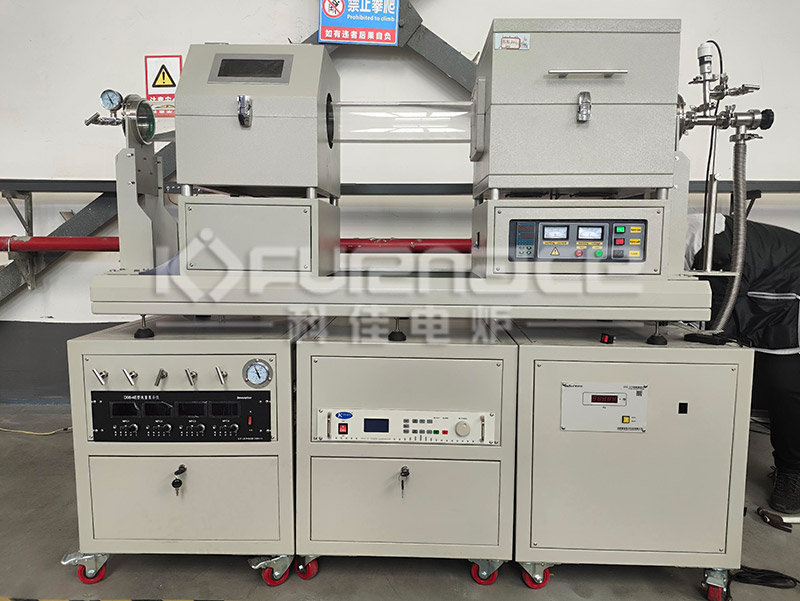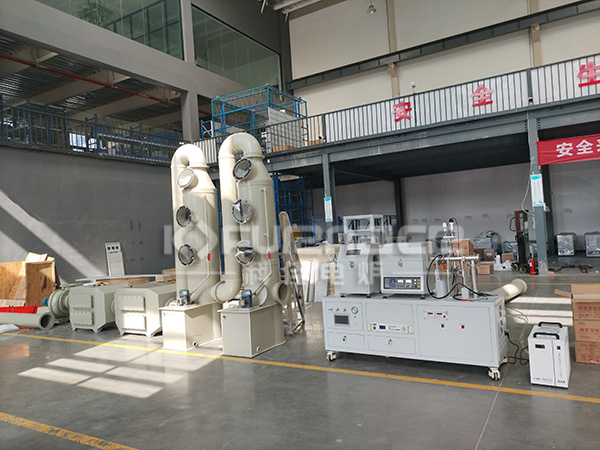When customizing PECVD electric furnaces, it is important to focus on five dimensions: core process performance, equipment compatibility and flexibility, operation and control accuracy, safety and environmental protection, and after-sales service and cost. Let’s take a detailed look below!

PECVD slide furnace commonly used for graphene growth (click on the image to view product details)
1. Core process performance: deposition rate and film quality
Deposition rate: Choosing a PECVD electric furnace with efficient deposition rate can significantly improve experimental efficiency and material utilization. For example, in the field of photovoltaic coating, efficient deposition rate can shorten the production cycle and reduce costs.
Uniformity of thin film: The equipment needs to form a thin film with highly consistent thickness and composition on the substrate, which is important for the reproducibility of experimental results and equipment performance. Poor uniformity of thin films may lead to unstable performance of photovoltaic cells, affecting the photoelectric conversion efficiency.
Temperature control accuracy: PECVD equipment should be able to operate at lower temperatures (such as room temperature to 350 ℃) and have good temperature control accuracy (within ± 1 ℃). Temperature fluctuations can affect the crystallinity, refractive index, and other properties of thin films, thereby affecting device performance.
2. Equipment compatibility and flexibility: material and process adaptation
Material compatibility: The equipment should be able to deposit multiple materials, including insulators, conductors, semiconductors, etc., to meet the needs of different research fields. For example, in the semiconductor industry, it is necessary to deposit dielectric thin films such as silicon dioxide and silicon nitride; In the field of photovoltaics, it is necessary to deposit a silicon nitride anti reflection film.
Process compatibility: The equipment should be able to be combined with other deposition techniques to form complex multi-layer structures or achieve specific functions. For example, high-precision optical thin films can be prepared by combining PECVD with ALD.
Precursor compatibility: The equipment should be able to use solid, liquid, or gaseous precursors for flexible selection of deposition materials and optimization of process conditions. For example, when depositing silicon nitride thin films, silane (SiH ₄) and ammonia (NH3) can be used as precursors.
3. Operation and control accuracy: gas flow rate, pressure, and real-time monitoring
Gas flow and pressure control: The equipment needs to be equipped with a high-precision flow and pressure control system to ensure the accuracy and stability of experimental parameters. Fluctuations in gas flow rate can affect the composition of the film, while unstable pressure may lead to a decrease in film density.
Real time monitoring and adjustment: The equipment should have real-time monitoring function and be able to adjust deposition parameters (such as RF power, gas flow rate, etc.) in real time to improve film characteristics. For example, by monitoring the thickness of the film in real-time, the deposition time can be dynamically adjusted to ensure the quality of the film.
Data recording and analysis: The equipment should have complete data recording and analysis functions to facilitate systematic analysis and summary of experimental results. Data recording can trace the experimental process and provide a basis for process optimization.
4. Safety and Environmental Protection: Protection and Emission Control
Safety protection function: The equipment should have safety protection functions such as over temperature protection, leakage protection, gas leakage detection and alarm to ensure the safety of experimental personnel. For example, a gas leak detection system can promptly cut off the gas source in the event of a gas leak, preventing explosion accidents.
Environmental performance: The equipment should have good environmental performance to reduce pollution to the environment. For example, using precursors of low volatile organic compounds (VOCs) to reduce exhaust emissions; Equipped with exhaust gas treatment equipment to purify exhaust gases.

Customized PECVD electric furnace with exhaust gas treatment device (click on the image to view product details)
5. After sales service and cost: maintenance and economic considerations
After sales service quality: Choose suppliers who provide comprehensive technical support and after-sales service to facilitate equipment maintenance and process optimization. For example, suppliers should be able to provide services such as equipment installation and debugging, operation training, and regular maintenance.
Equipment cost: Select appropriate equipment grade and specifications based on research budget and actual needs. On the premise of ensuring equipment performance and quality, try to choose equipment with high cost-effectiveness.
Operating costs: Consider the operating costs of the equipment, including gas consumption, electricity consumption, and maintenance expenses. For example, high-frequency RF power supply may increase power consumption and long-term operating costs need to be evaluated.
Click to learn more PECVD devices! Or click on online customer service to learn more about product information!